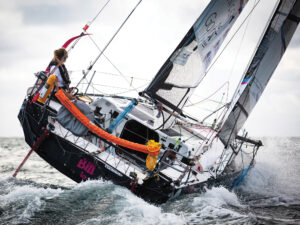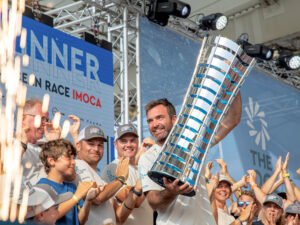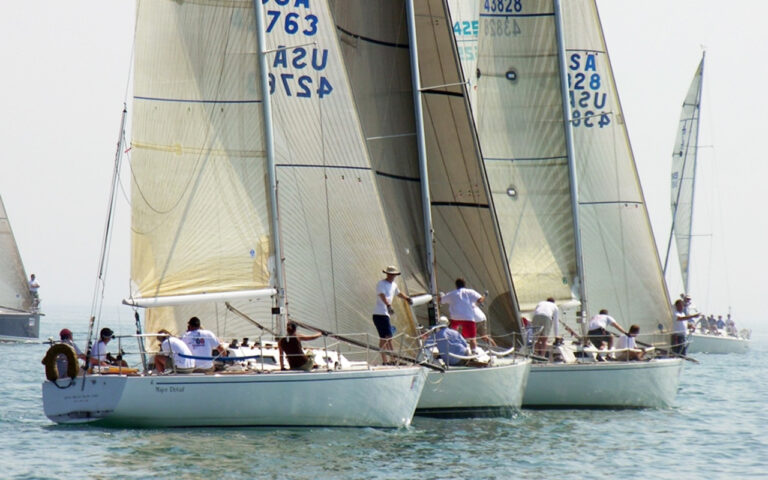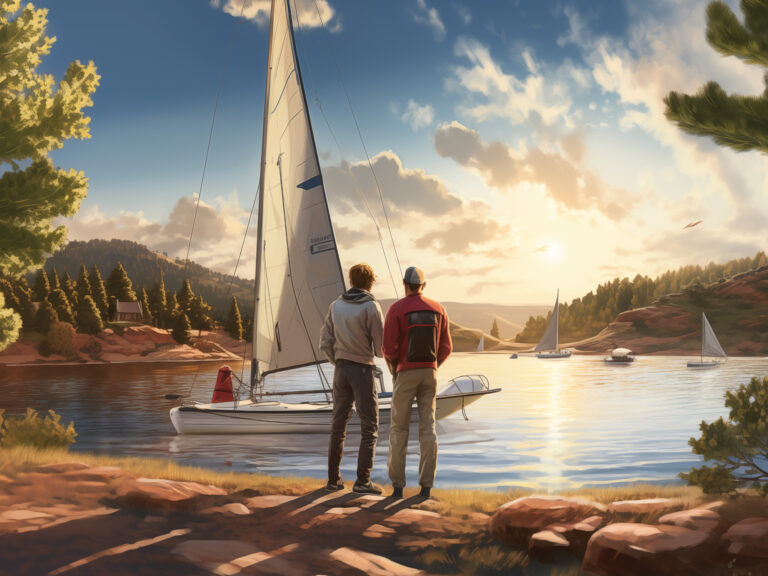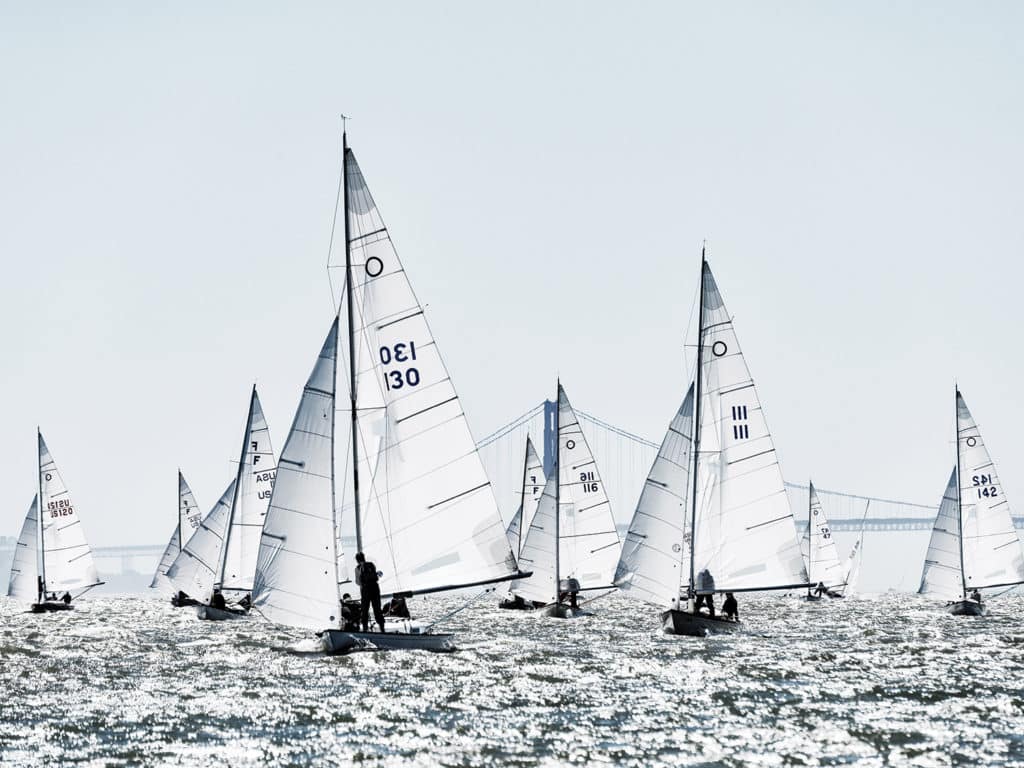
Word has it that if you bottled the secret sauce of the Knarr, every class would buy some. But there are things that can’t be bottled, can’t be bought. Sailors always tell you, “It’s about the people.” Knarr sailors say it too—except, there’s more: all of it against the odds, much of it unique, with a kernel of anti-Nazi intrigue in the origin story. It’s a pretty boat, and it’s all about the people.
Knarr sailors have their own cheer, their own regalia, their own “circuit” that is unlike any other. The design is seven decades old. The bragging-rights regatta is the International Knarr Championship, born on San Francisco Bay in 1969—and, did we mention, against the odds?
Name another class with a 52-year tradition of a championship regatta that rotates annually among three countries; where visiting sailors are hosted in private homes; where boats are provided from a local fleet, but none of the locals sail their own boats; where pros pop in, but nobody gets paid; and the parties are as competitive as the sailing—you better believe it.
The IKC is the spice in the sauce. Without it, this would be just another 30-foot one-design class that might or might not be surviving—much less thriving—in the three countries where it thrives in the way of a flower that grows in only a few meadows on only a few mountains, at a certain elevation, where a delicate balance of moisture provides just enough days of summer sun. With an international, multigenerational cult of followers.
To the best of my knowledge, there are no blood rituals, but rituals? Oh, baby. In the early 1960s, Knud Wibroe was developing some unlikely ideas. Of course, there’s a story.
Wibroe is a Dane transplanted to San Francisco Bay, and in these circles, “Knud” is a one-word name on par with Elvis. He never lost touch with his roots, and he spent time back in Denmark, even keeping a Knarr there for racing.
However, our story begins years earlier, when Wibroe took up racing lapstrake-hulled Folkboats on San Francisco Bay. And helped build the fleet to 70 boats. And launched summertime Wednesday-evening races “that became the backbone of our racing,” he says. “When the Knarr appeared, we added starts for the Knarr. I knew the boat. I had seen Knarrs in Denmark, and they look the way a boat ought to look. On San Francisco Bay, because they’re underrigged, they’re a good fit.”
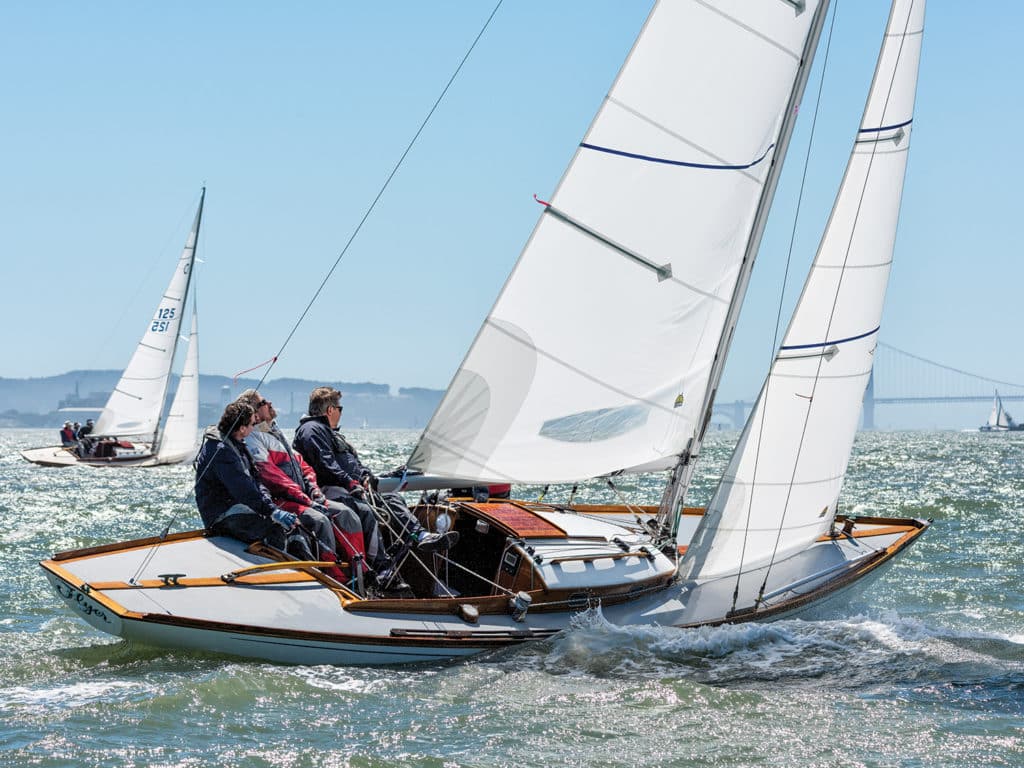
Wibroe soon was sailing a Knarr. However, he had the only Danish‑built hull on the bay. The rest came from Norway; when he won too many races, there was talk that it was something about the boat. “So I said, ‘Let’s switch boats,’” Wibroe says. “We didn’t know it, but that was the beginning.”
Shift scenes now to Denmark, where Wibroe spent a month each summer and preached the virtues of coming to San Francisco Bay to race—but won no converts. “I told them we had 42 Knarrs,” he says. “They thought I was talking Texas numbers.”
So it went, but by-and-by, the calendar came up 1966. Wibroe was the only US skipper on the line for the 100th-anniversary regatta of the Royal Danish Yacht Club, helming a new boat set up by Paul Elvström with a new main: “Paul and I grew up together, so he did that; and he told me, ‘You’re going to win because I tuned the boat.’ Paul was that way.”
Three firsts and a couple of second-place finishes later, Wibroe was in fact the winner.
The way he remembers it: “That boosted my credibility. We had rented a house, and we gave dinner parties and urged our European friends to reciprocate by attending the centennial regattas of the San Francisco Yacht Club. That would be 1969.”
A new boat every day, by draw, was the center of the promise. And the locals would have to qualify by placing at the top of their entire season; all skippers of loaner boats would be required to offer their newest sails—and remember, no local would sail his own boat.
Wibroe recalls: “No one would be handed a clunker, and we’d buy new jibs for the fleet—and every person who came would be put up in a private home. San Francisco is on the other side of the world, OK. But all you need is a round-trip ticket. We’ll take care of everything else. That was the pitch.”
And they came.
“I never imagined this would grow into what we have today,” he says, “but that first year set us up. We gave theatricals. We made music. We gave them a psychedelic show because those were the times. Our wives wore hot pants because those really were the times. The Europeans had never seen anything like it. They loved it.”
That is, to this day, the over-the-top template for an International Knarr Championship as it rotates among San Francisco Bay, Hellerup in the Danish suburbs north of Copenhagen and, in Norway, between Bergen and Oslo. If you qualify from your local fleet, you will be met at the airport and whisked away to pampering among people you know—and perhaps have known for a long time—with celebrations daily and sailboat racing as the best-imaginable excuse.
Johan Hvide, a second-generation Knarr sailor and 10-time Norwegian champion, says that arriving at an IKC is “like coming home.” At moderate cost, this is Corinthian yachting at its finest; and yes, “yachting” is the right word, even though the back-of-mind thought as designer Erling Kristofersen began drawing up his Dragon-inspired lines was far from obvious. Under the shadow of World War II, one key to the design brief was the ability to sail away, perhaps as far as England, to escape the Nazis. However, by the time Einer Iversen set about building a boat, the seas were too closely guarded for any hope of escape.
RELATED: Back on the Bay
During the Nazi occupation of Norway, all seagoing yachts were confiscated, their lead keels fated for the Wehrmacht. But the urge to build prevailed, and hull No. 1 emerged plank by plank in a shack in the woods on the shore of the Oslo Fjord. It was built over an inside mold, a “last,” which in the long run would prove amenable to limited-series wood production. Materials were hard to come by, but Iversen as a builder was innovative, persistent, willing to settle for an iron keel and willing to source hardware from an ironmonger who was dealing with Germany—which might have been how the foreign overlords got wind of the project.
However that came about, the occupiers quickly served notice that they would take possession upon its completion. Iversen soldiered on anyway, and eventually completed and launched ON 1. Upon returning from sea trials, a profoundly embarrassed Iversen reported to the authorities that the prototype he had produced was ridden with problems and “unworthy of the master race.” He promised to have a seaworthy boat ready by summer ’45.
Berlin fell the following spring.
Given the name of Knarr after a Viking cargo craft—in the Oslo Fjord, they pronounce the “K”—the new boat was presented to the public that fall. Some found the freeboard high and the sheer excessive, but in the stressed postwar environment, the price tag was attractive.
Orders came in. Hull No. 4 is still sailing in 2020.
The 51st IKC came to San Francisco Bay this past fall, landing this time on the 150th anniversary of the San Francisco YC, the oldest yacht club on the West Coast and harbored on the north shore of the bay, opposite the city. Most Knarr racing on the bay these days is staged out of either that club or its 1927 splinter residing on the city front, St. Francis YC, where the Wednesday-night racing tradition continues. Among names you know, Paul Cayard qualifies as what we’ll call an occasional regular. He reports, “It took me 15 years to win a Wednesday-night race.”
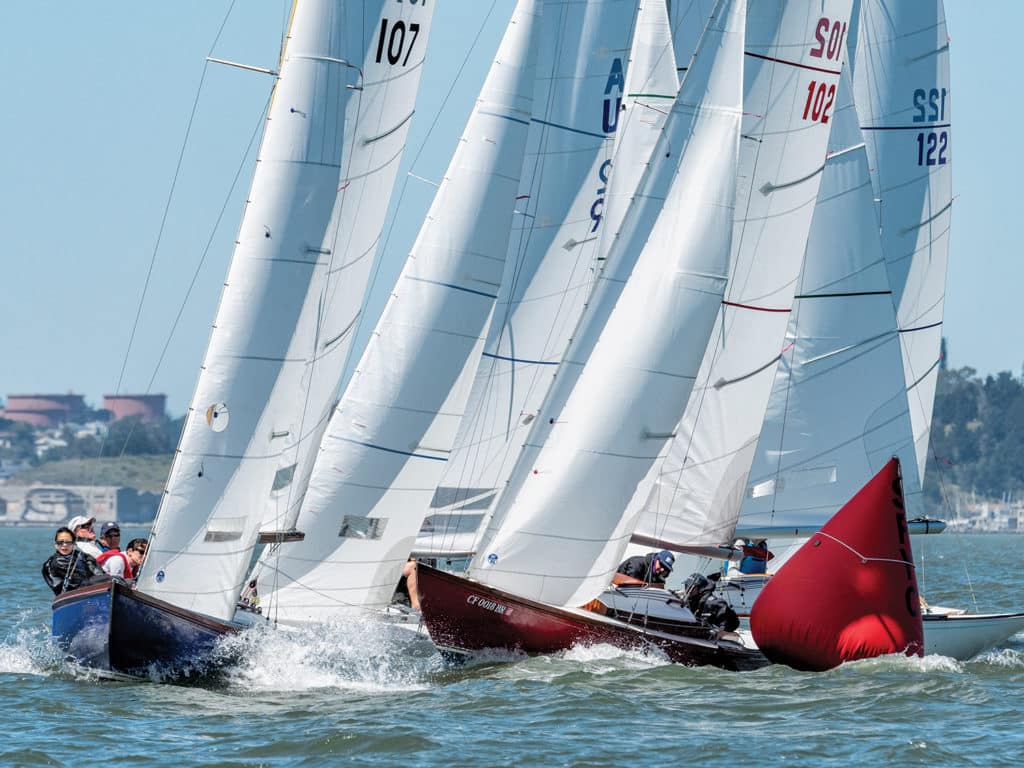
The two clubs on opposite shores share DNA and members in common, including the Perkins brothers—Chris, Jon and Phillips—who have their own place in the Knarr story. Between them, Chris and Jon have each won four IKCs, at home or in Europe. Phil is a regular crew, and for the past 10 years, the brothers have teamed up for Wednesday-night races aboard No. 125, which has history in the Perkins family. The boat was built, plank on frame, in 1965, the year Jon was born, and it later became, he says, “the first boat my parents sailed on when they were trying to figure out what to do with us as junior sailors.”
The boat was owned at the time by Grant Settlemier, who would eventually become one of 16 Knarr-owning commodores of St. Francis YC. Soon 125 was providing early sailing experience for the growing Perkins boys.
“We put a lot of hours on that boat,” Jon recalls. As an adult, he bought a late-edition glass Knarr but spent years “courting” a later owner of 125 until she relented and sold him the boat. The restoration that ensued “was something I probably wouldn’t do again,” he says, “but now I wouldn’t let go of this boat for anything.”
The Knarr class survived by introducing fiberglass hulls calibrated for overall weight and weight distribution to match the traditional fleet, with the first glass hulls appearing in 1973. The experiment was a success. There’s not much to choose from between the materials, though a rule of thumb suggests that glass boats have minor advantages in wind speeds of less than 15 knots. However, in the case of his wood 125, Jon says, “between 5 and 12 knots, I’ll take my boat over any in the fleet.” Another way to put that is: You can’t buy your way to a championship, and the rest of it will keep people talking at the bar for as long as there are bars and Knarrs.
In 2006, in Hellerup, Denmark’s Soren Pehrsson became the first second-generation IKC champion. He had won 25 years before as crew, pulling strings for his father, Alf, and saw no reason to leave the fleet. He won again in 2013. Of the Perkins brothers, he observes: “It’s not that you can’t beat them. It’s just that they are so terrifyingly good race after race.”
Pehrsson did not compete in the 2019 IKC, when Lars Gottfredsen, of Denmark, became the first five-time champion, rounding out his ambition to win in San Francisco after three wins in Norway and one in Denmark. Jon Perkins was third. Chris was fourth.
And with that, we sink deep into the sauce of the Knarr class, into this tight group of people who have their own thing going.
It is a fact that most of the world’s sailors could not care less who wins the IKC when it moves to Bergen, Norway, this year. It is equally true that Knarr-class sailors could not care less that the world does not care. In a perfect world, we play games with our friends, and this might be as close to perfect as it comes.
Chris Perkins, like his brothers, had the chops to go pro but didn’t. Over the years he focused on J/105s, for example, and treated the Knarr as a second fleet until recently, when family life made demands. His glass boat, he says, “is easy on my time. It takes a few hours of maintenance every year, and you can do that at the beginning, the end, or the middle of the season.”
As for a formula for success on the racecourse: “The boat is heavy and not technical. If you lose momentum, it takes a long time to get going, so the pressure is on the helmsman and trimmer to develop a precise feel together and to balance the boat just so. In the past few years, the Knarr has become one of the most competitive classes going. I’m kind of shocked that we’re still doing this, but the Wednesday nights keep me anchored in the class and, honestly, the racing gets better and better.”
There’s that word: anchored. No one ever really leaves the Knarr class. Even if they sell the boats, they show up for the parties, and most just keep on keeping on.
Terry Anderlini is another Knarr-owning St. Francis YC commodore, and his history parallels the IKC’s. He arrived in the fleet in 1969 while the inaugural regatta was ramping up. He came in with an offer to buy No. 102, which at one time belonged to Wibroe. That led to a call from the man himself, who was darned well going to give this new guy the third degree before he would bless the sale.
With Wibroe’s blessing in hand, Anderlini was allowed to buy 102; but in his newbie role, he declared that the proposed boat-sharing format for the IKC “was crazy; would never work” and worse, it would be “embarrassing to watch your own boat beat you.”
He now admits he was wrong on the first count. On the other, not so much. ν

